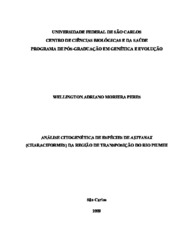Análise citogenética de espécies de Astyanax (Characiformes) da região de transposição do rio Piumhi

Visualizar/
Data
2009-06-19Autor
Peres, Wellington Adriano Moreira
Metadata
Mostrar registro completoResumo
The transposition of the Piumhi River caused the introduction of many aquatic species in the São Francisco basin. Species previously restricted to the Upper Paraná basin, such as Leporinus octofasciatus and Parodon nasus, are now present in the São Francisco basin. However, the morphological identification of the invaders is not always possible. This becomes evident in the cases where the invading species are cryptic of native species, and when the newly introduced species already has a resident population. Therefore, the present work had the objective of characterizing and mapping the dispersion of a few invader species in the São Francisco basin using cytogenetic markers. Populations of Astyanax altiparanae, A. fasciatus and A. lacustris were analyzed. Besides a large chromosomal similarity, chromosome polymorphism where the two species were in sympatry was evidenced between the cryptic species A. altiparanae and A. lacustris, suggesting the occurrence of hybridization. On the other hand, differentiations regarding quantity and distribution of C-bands, AS-51 satellite DNA sites, Ag-NOR sites, and 18S and 5S rDNA sites, were seen between the A. fasciatus populations from the Upper Paraná and São Francisco basins. These chromosomal markers differentiated species from the Upper Paraná basin that invaded the São Francisco basin. No specimens with intermediary chromosomal characteristics between the native and introduced populations were found. This fact suggests that the Upper Paraná populations may constitute a distinct species.